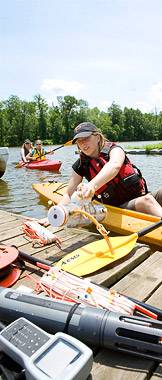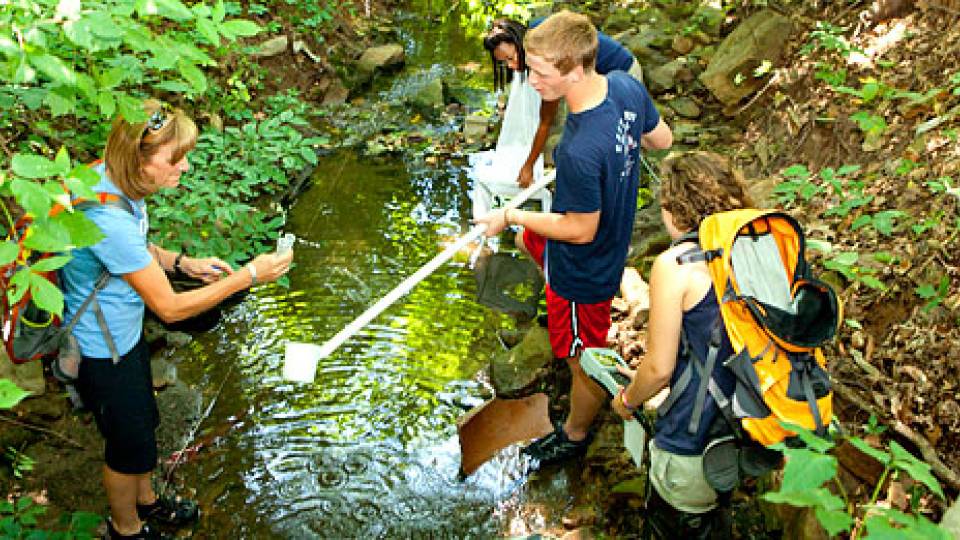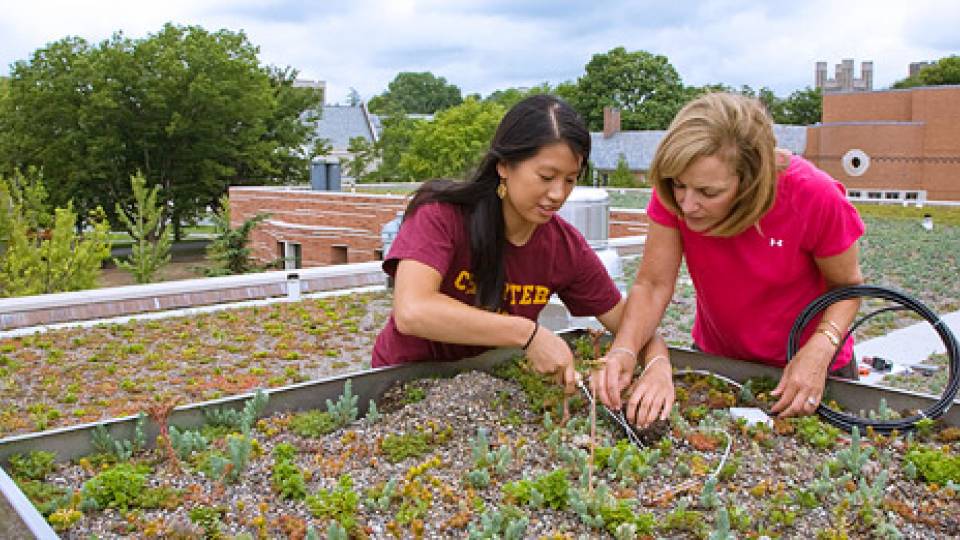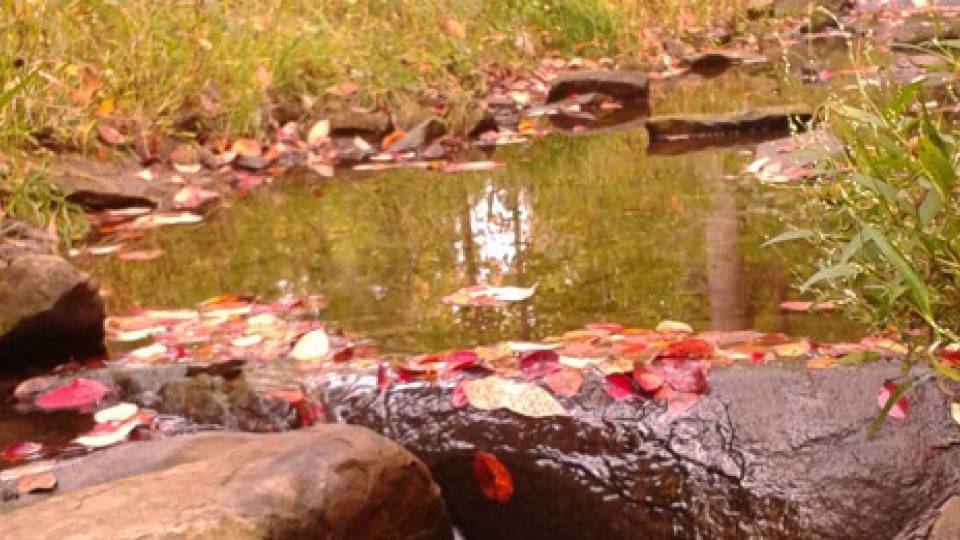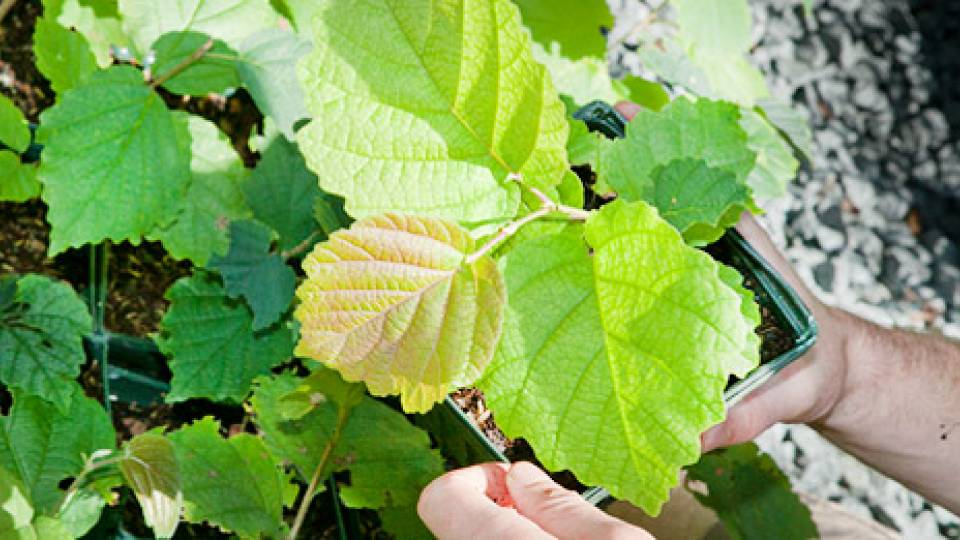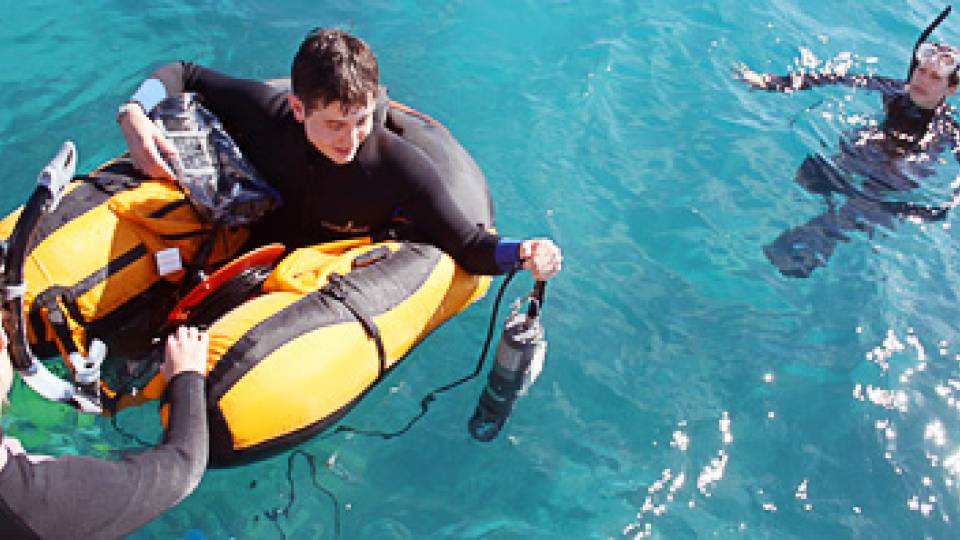You have to love nature, rising junior Stephanie Hill said, when you grow up, as she did, in a remote, pristine village on the shores of a glacier-fed lake in British Columbia.
Megan Prier, a rising sophomore who hails from suburban Malvern, Pa., developed her passion for environmental issues in a different way. She became inspired about the possibility for change in high school after watching a documentary film on global warming.
And Reid Fritz, a rising junior from San Diego, Calif., said he can't remember a time when he wasn't interested in all things aquatic.
Together, these Princeton University students have embarked on a unique project this summer with others to study Lake Carnegie, its ecosystem and the streams that feed into it, part of a major, long-term effort that will complement University-wide goals to develop and expand in environmentally sustainable ways.
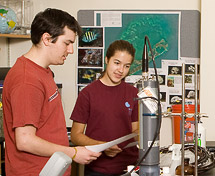
Travis Zerba (left), a member of PEI's information technology staff and a computer science major at Moravian College, consults with Megan Prier, a Princeton student, about the website they are developing for her research. Students in the research project will share their results through media projects linked to an interactive website. It will feature real-time data from a water monitoring probe deployed within the deepest part of Lake Carnegie.
By participating in the Summer Undergraduate Research Training Program at the Princeton Environmental Institute (PEI), the students are playing key roles in an ambitious, multi-year environmental monitoring program that is kicking off this summer. The goal is to help improve water quality and ecological balance across the campus and within the Stony Brook-Millstone Watershed, with the 237-acre Lake Carnegie at its center. The Princeton campus sits on a natural hillside with the lake valley on its southern edge, making it a natural drainage basin.
As project managers of their own experiments, the students must map out a plan and establish procedures that will yield statistically significant data that will help them begin to assess the very health of the lake and its contributing rivulets. This summer, they must record the all-important "baseline" measurements reflecting the biological, chemical and physical constituents of Lake Carnegie and major stream drainages, such as the Washington Road stream that is slated for restoration, enhanced floodplain and added wetland features.
"This is a chance to work on an important independent project and on issues that I find very interesting," said Hill, a politics major who is also a leader of the student environmental group Greening Princeton.
She can imagine drawing the particulars of her senior thesis project from her research. "I am trying to understand how policy is developed and how decision-making works in the public sphere," Hill said. "Doing a project like this where we get to talk to the very people who will be making decisions, such as engineers and landscape architects, and see how it all gets put into place, will be fascinating."
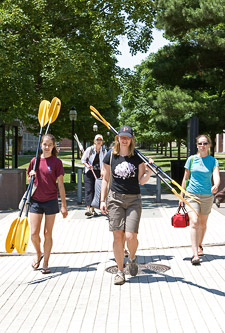
Students in the research program divide their time between labwork in Guyot Hall and fieldwork in kayaks on Lake Carnegie. The lake and contributing streams they are studying are located only a short walk away -- across Washington Road and down the hill.
The University's Campus and Sustainability Plans, finalized in 2008, are aimed at balancing sustainable growth with parallel improvements in infrastructure, transportation and open space. They emphasize sustainable building design, expanded landscaping and reforestation, stream restoration, increased conservation and recycling, and improved water management.
The students in the summer research program divide their time between two work areas -- their bright, airy laboratory in Guyot Hall and their other "laboratory," Lake Carnegie, located a 10-minute walk down Washington Road. Their kayaks, one of them equipped with sonar used to map the depth of the lake, are stored near the water. But they carry their oars and monitoring equipment.
With sunlight raining down on them, students in the program spent a recent day in the kayaks, collecting water samples and making measurements of dissolved oxygen, chlorophyll, turbidity and pH with a probe that can record and store data throughout their journey down the lake. At the same time they noted native plants and wildlife they spied along the way, including a heron. The sampling is part of a routine they have developed for the duration of the summer.
Prier, who plans to major in civil and environmental engineering and is a member of the student group WaterWatch, will test the lake water samples later in the lab for levels of nutrients that often result when water washes into the lake and area streams from stormwater runoff -- ammonium, nitrate, nitrite and phosphate. Hill will test water samples taken from the Washington Road stream for the same constituents. Fritz, who is majoring in ecology and evolutionary biology, is tracking fish populations in the lake from schools of sunfish to pickerel. He also is taking tallies of the macroinvertebrate population, including nematodes and flatworms, to evaluate the health of the stream.
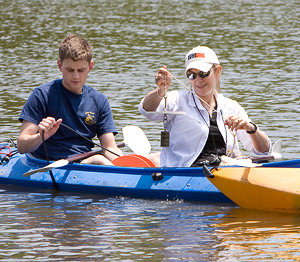
Eileen Zerba, the principal investigator on the research project and the director of undergraduate laboratories at PEI, designed the project to involve hands-on monitoring and real-life observations taken on Lake Carnegie and in the immediate area. Here, Zerba, along with Princeton student Reid Fritz, are tracking fish populations in the lake.
Beyond gleaning specific knowledge from such a program, the students also will learn the rigors of academic research and explore topics that could provide the basis of their junior papers and senior theses. As the work advances and the students continue their explorations through advanced environmental science classes, they also expect to publish their results in a peer-reviewed scientific journal, in partnership with their adviser, Eileen Zerba, the principal investigator on the project and the director of undergraduate laboratories at PEI. In addition, students will share the results of their work with the community through media projects linked to a new environmental studies interactive website featuring real-time data.
As Zerba sees it, students who are working on the project will develop a sense of stewardship for the area, kindling their leadership abilities. "What we always hope is that we are developing students here who will be role models for their communities," said Zerba, also a lecturer in ecology and evolutionary biology and freshman seminars. "We want to develop critical thinkers, problem solvers and scholars -- an important goal of undergraduate education."
The project is being funded by the High Meadows Foundation, PEI, the Community-Based Learning Initiative and the facilities department, which support the summer work as well as development of a new course on "Environmental Challenges and Sustainable Solutions" that Zerba will teach.
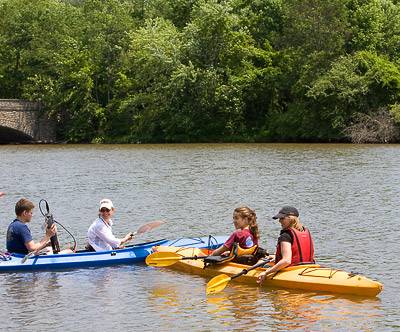
This summer, the research group will record important baseline measurements reflecting the biological, chemical and physical constituents of Lake Carnegie and major stream drainages. They will be collecting water samples all summer. The project is part of a long-term effort that will complement University-wide goals to develop and expand in environmentally sustainable ways.
The water monitoring efforts by the students are part of a larger project being managed by Zerba that also will address the impact of a "green roof" design (under construction at Butler College) on stormwater runoff and on energy use for heating and cooling. The goal of the long-term monitoring project is to better understand how land use changes, driven by the University's plans, will affect the biological, chemical and physical characteristics of Lake Carnegie, the regional watershed, surrounding natural habitats and landscapes within campus. That knowledge, in turn, will inform sustainability policies for the future.
Participants in the program will include Princeton faculty, PEI technical staff, facilities and information technology staff, undergraduates taking introductory and advanced environmental sciences courses, and volunteers from student groups and community partners such as the Stony Brook-Millstone Watershed Association.
